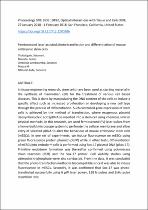 ResearchSpace
ResearchSpace
Femtosecond laser assisted photo-transfection and differentiation of mouse embryonic stem cells
JavaScript is disabled for your browser. Some features of this site may not work without it.
- ResearchSpace
- →
- Research Publications/Outputs
- →
- Conference Publications
- →
- View Item
| dc.contributor.author |
Thobakgale, Setumo L

|
|
| dc.contributor.author |
Manoto, Sello L

|
|
| dc.contributor.author |
Ombinda-Lemboumba, Saturnin

|
|
| dc.contributor.author |
Maaza, M

|
|
| dc.contributor.author |
Mthunzi-Kufa, Patience

|
|
| dc.date.accessioned | 2018-09-18T09:41:32Z | |
| dc.date.available | 2018-09-18T09:41:32Z | |
| dc.date.issued | 2018-01 | |
| dc.identifier.citation | Thobakgale, S.L. et al. 2018. Femtosecond laser assisted photo-transfection and differentiation of mouse embryonic stem cells. Proceedings SPIE BIOS 10492, Optical Interactions with Tissue and Cells XXIX, 27 January 2018 - 1 February 2018, San Francisco, California, United States: https://doi.org/10.1117/12.2290206 | en_US |
| dc.identifier.isbn | 9781510614697 | |
| dc.identifier.isbn | 9781510614703 | |
| dc.identifier.uri | http://spie.org/Publications/Proceedings/Paper/10.1117/12.2290206 | |
| dc.identifier.uri | https://doi.org/10.1117/12.2290206 | |
| dc.identifier.uri | http://hdl.handle.net/10204/10409 | |
| dc.description | Copyright: SPIE. Due to copyright restrictions, the attached PDF file only contains the abstract of the full text item. For access to the full text item, please consult the publisher's website. | en_US |
| dc.description.abstract | In tissue engineering research, stem cells have been used as starting material in the synthesis of mammalian cells for the treatment of various cell based diseases. This is done by manipulating the DNA content of the cells to induce a specific effect such as increased proliferation or developing a new cell type through the process of differentiation. Such controlled gene expression of stem cells is achieved by the method of transfection, where exogenous plasmid deoxyribonucleic acid (pDNA) is inserted into a stem cell using chemical, viral or physical methods. In this research, we used femtosecond (fs) laser pulses from a home-build microscope system to perforate the cellular membrane and allow entry of selected pDNA to alter the behaviour of mouse embryonic stem cells (mESCs). In one set of experiments, we induce fluorescence on mESCs using green fluorescence protein plasmid (pGFP) while in other tests; differentiation of mESCs into endoderm cells is performed using Sox-17 plasmid DNA (pSox-17). Primitive endoderm formation was thereafter confirmed using polymerase chain reactions (PCR) and the Sox-17 primer. Cell viability studies using adenosine triphosphate were also conducted. From the data, it was concluded that the photo-transfection method is biocompatible since it was able to induce fluorescence in mESCs. Secondly, it was confirmed that Sox-17 was photo-transfected successfully using 6 µW laser power, 128 fs pulses and 1kHz pulse repetition rate. | en_US |
| dc.language.iso | en | en_US |
| dc.publisher | SPIE | en_US |
| dc.relation.ispartofseries | Worklist;21216 | |
| dc.subject | Photo-transfection | en_US |
| dc.subject | Femtosecond | en_US |
| dc.subject | Differentiation pGFP | en_US |
| dc.subject | pSox-17 | en_US |
| dc.subject | Primitive endoderm | en_US |
| dc.title | Femtosecond laser assisted photo-transfection and differentiation of mouse embryonic stem cells | en_US |
| dc.type | Conference Presentation | en_US |
| dc.identifier.apacitation | Thobakgale, S. L., Manoto, S. L., Ombinda-Lemboumba, S., Maaza, M., & Mthunzi-Kufa, P. (2018). Femtosecond laser assisted photo-transfection and differentiation of mouse embryonic stem cells. SPIE. http://hdl.handle.net/10204/10409 | en_ZA |
| dc.identifier.chicagocitation | Thobakgale, Setumo L, Sello L Manoto, Saturnin Ombinda-Lemboumba, M Maaza, and Patience Mthunzi-Kufa. "Femtosecond laser assisted photo-transfection and differentiation of mouse embryonic stem cells." (2018): http://hdl.handle.net/10204/10409 | en_ZA |
| dc.identifier.vancouvercitation | Thobakgale SL, Manoto SL, Ombinda-Lemboumba S, Maaza M, Mthunzi-Kufa P, Femtosecond laser assisted photo-transfection and differentiation of mouse embryonic stem cells; SPIE; 2018. http://hdl.handle.net/10204/10409 . | en_ZA |
| dc.identifier.ris | TY - Conference Presentation AU - Thobakgale, Setumo L AU - Manoto, Sello L AU - Ombinda-Lemboumba, Saturnin AU - Maaza, M AU - Mthunzi-Kufa, Patience AB - In tissue engineering research, stem cells have been used as starting material in the synthesis of mammalian cells for the treatment of various cell based diseases. This is done by manipulating the DNA content of the cells to induce a specific effect such as increased proliferation or developing a new cell type through the process of differentiation. Such controlled gene expression of stem cells is achieved by the method of transfection, where exogenous plasmid deoxyribonucleic acid (pDNA) is inserted into a stem cell using chemical, viral or physical methods. In this research, we used femtosecond (fs) laser pulses from a home-build microscope system to perforate the cellular membrane and allow entry of selected pDNA to alter the behaviour of mouse embryonic stem cells (mESCs). In one set of experiments, we induce fluorescence on mESCs using green fluorescence protein plasmid (pGFP) while in other tests; differentiation of mESCs into endoderm cells is performed using Sox-17 plasmid DNA (pSox-17). Primitive endoderm formation was thereafter confirmed using polymerase chain reactions (PCR) and the Sox-17 primer. Cell viability studies using adenosine triphosphate were also conducted. From the data, it was concluded that the photo-transfection method is biocompatible since it was able to induce fluorescence in mESCs. Secondly, it was confirmed that Sox-17 was photo-transfected successfully using 6 µW laser power, 128 fs pulses and 1kHz pulse repetition rate. DA - 2018-01 DB - ResearchSpace DP - CSIR KW - Photo-transfection KW - Femtosecond KW - Differentiation pGFP KW - pSox-17 KW - Primitive endoderm LK - https://researchspace.csir.co.za PY - 2018 SM - 9781510614697 SM - 9781510614703 T1 - Femtosecond laser assisted photo-transfection and differentiation of mouse embryonic stem cells TI - Femtosecond laser assisted photo-transfection and differentiation of mouse embryonic stem cells UR - http://hdl.handle.net/10204/10409 ER - | en_ZA |





